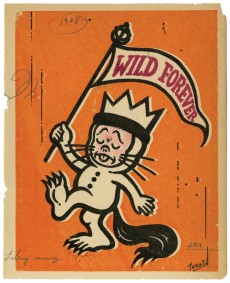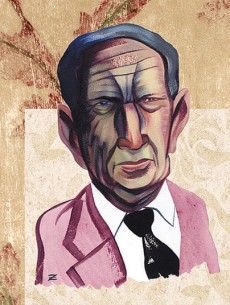
Gary Taxali
Illustration was born with us. From prehistoric cave painting to the more onerous early political-cartooning that is Roman cameo. From Medieval illuminated manuscript through America’s Golden Age of Illustration. Blake to Rockwell to Warhol – we have been communicating through images (prior to and accompanying text) since our inception.
Likewise, writing was initially lithographic – mirrored in the way that children learn to read modern language; matching visual cues to meanings long before attempting phonetics.
With something so inherent to our origins about illustration, it would be surprising if all illustrators didn’t delve into children’s books. Kid-In sat down with Gary Taxali and Michael Zaharuk , friends, fine artists and illustrators – also for that genre – to discuss sources of inspiration and the future of this enduring art form.

Michael Zaharuk
Taxali’s densely layered, iconic yet enigmatic, playfully satirical images find equally prolific footing in the fine art, commercial and editorial worlds. Between a succession of shows at international top galleries, the artist and toy designer balances commissions for The New York Times and Time Magazine with artwork for Aimee Mann cds jackets and Jonathan Letham book covers.
To enjoy the delightfully arched and deliciously pointed, always conscientious and often incendiary work of Zaharuk, you should brush up on your politics. Zaharuk incorporates an adoration of all things left into every aspect of his uniquely stylized works – why The Utne Reader, The Progressive and Greenpeace all call on him for intensely impactful visual commentary.
What the two hold in common, besides friendship and a field, is their tie – through the act of illustrating – to our childhood origins and to the origins of Culture.
How did you meet?

Gary Taxali
GT: We met as students at the Ontario College of Art, and became fast friends – similar likes and interests (including our love of Roots Reggae and Ska). Upon returning from time spent living in NYC, I rented a large warehouse loft with Mike. A lot of hilarious trials and tribulations ensued, and we enjoyed many parties and adventures. Still, we worked hard as artists and it was inspiring having a supportive friend in Mike.
MZ: We had similar tastes in illustration and music! As a student, Gary’s work was advanced – he was already published in major magazines and he’d show me tear sheets! When Gary and I moved into our loft, it was completely run down – didn’t even have running water. We turned it into two great living spaces. It’s been years since, and that rundown warehouse area has tried to keep its artist community intact, but unfortunately it’s more offices and condos currently.
Describe your childhood artwork?

Gary Taxali
GT: My kindergarten report card stated that I loved to draw pictures from class story-time. I’ve always been fascinated by connecting words to images – what led me to becoming an illustrator and children’s book author. In my fine art work it’s the same; narrative structures connected to words and themes.
MZ: The first art I did as a child was cartoons. Some are still preserved on the side of a family chest of drawers – a testament to my mother’s tolerance. Both my parents encouraged my creativity; summer art lessons while we stayed at cottages up north, entering talent contests, always drawing caricatures and cartoons.
What experience from your childhood prepared you for your career?
GT: The love and support of my family. It instilled in me the confidence to pursue art as a career. My father could draw and paint very well too, and so he would teach me as well. I dedicated my children’s book, This is Silly! to my mother. When I was a child, my teachers were constantly telling me to stop acting silly, whereas at home my mother would encourage it! That made me realize it was OK to be my silly self.

Michael Zaharuk
MZ: My first published cartoon, which appeared in my fifth-grade yearbook. It was a drawing of a body builder with the caption: “Last year I was conceited, this year I’m perfect!” The caption was probably plagiarized, but when you’re ten people go easy on you. It may also have been the attention I received from my fellow classmates that kept me interested in drawing.
Is illustration an inherently child-like medium?
GT: I think the best ideas are the ones that communicate in simple, graphic ways. That said, the simplest ideas can be perceived as complex in their brilliance. It’s like a Beatles song – so simple yet smart. I don’t know if I achieve that in my work but it’s what I strive to attain.
MZ: Illustration can often have a child-like appearance. It distills complex ideas into easily understandable imagery. At its best it’s concise enough to be accessible to the masses as well as clever enough to appeal to the most knowledgeable on the subject.
Who, from your childhood, influenced you most and why?

Gary Taxali-Kid Robot
GT: Dr. Seuss was and still is my favorite. I also loved Maurice Sendak. I would read their books before I could actually read. The pictures opened up the entire world and its possibilities for me. When Sendak passed away last May, I was humbled and honored to receive a call from The New York Times asking me to do a visual tribute to him and write a little something. I created an image featuring one of my characters dressed in Max’s costume from Where the Wild Things Are.
MZ: My father was a trained painter and film and commercial set designer. His paintings, from Art College and beyond, hung all over our house. My mother, who never pursued art, also kept some of her early humorous sketches. They were very, very good as well. All of this was a huge influence on me.
What are some other childhood inspirations?

Michael Zaharuk
GT: Saturday morning cartoons were a big love for me. As well, my father bought me a bunch of MAD Magazine paperback compilations that had a huge impact on me, especially the work of Bill Elder – a direct influence on my work in in my early years.
MZ: Also for me, Dr. Seuss was a big childhood influence. He actually spent much of his early career as a political cartoonist! I was strongly influenced by various B-Hollywood horror movies as well, such as King Kong.
Why did you decide to do children’s books?

Gary Taxali- “This is Silly” Children Book
GT: It was something that I always wanted to do but never gave it serious thought. Out of my drawings and painting an idea germinated, something that in retrospect seems so easy! It has inspired me to write more, and of course, draw and paint a bigger expanse of ideas.
MZ: Children’s book illustration was an attempt to recapture some of this early childhood inspiration. It was also a way to take a mental break from some of the political subject matter that I usually deal with.
Is it a natural fit: your fine art work or political illustration and illustrations for children?
GT: When I illustrated my kid’s book, I wanted the palette colorful and candy-like to appeal to children. Beyond that, a child can see right through dishonesty. It’s easier to dispense with false notions of understanding how kids think, and just write and draw what one likes. Seuss and Sendak never had children (Seuss feared being around them), yet both are praised for understanding them. They understood the human condition and how to channel their inner child into picture books. That level of honesty speaks to children.

Michael Zaharuk
MZ: It is a natural fit stylistically. I’m so used to drawing and painting in a humorous style that children’s book illustration wasn’t a huge stretch for me. Using humor in illustration is very common, using it in the fine art world can be a bit of a break with tradition. I enjoy using humor – and in children’s book illustration, humor is an asset.
What do you each think that the other brings to his field of illustration?
GT: I love Mike’s conceptual wit, his color sensibility and the way his work is political but wholly original – separate from typical political cartoons. He brings a fresh, stylized, illustrative approach to his work – which employs great mixed media techniques. His caricatures are great; I’m in awe of how he retains the likeness of his subjects while the art remains very “Mike”. Not many artists can pull that off. We’re both fans of utilizing typography in our work. His hand-rendered fonts have as much sophistication and personality as his characters. I love that about his work.

Gary Taxali
MZ: Gary’s work is extremely, extremely sophisticated. I’m always amazed by the quality of the work. There is always something surprising to enjoy in his paintings; an unexpected twist or subtle detail you catch in the piece. Conceptually the work is clever! He’s also a brilliant designer; he makes an image with highly developed design look effortless. It’s organic; intricate yet graphically simple. Humor is definitely an element of his work that I love. It’s amazing to see sophisticated work that also has a sense of humor. Gary’s also versatile; he produces lots of work that always seems to have a new feel to it.
If you each never decided to go into illustration, what would you be doing now for a living?
GT: Drawing pictures at my desk lamenting how I wished I were an artist.

Michael Zaharuk-Tax Shelters
MZ: Probably I would have gone into another creative medium (film making, acting or animation). Also, news, writing and politics have also always interested me.
What is your favorite piece from the other’s repertoire, and why?
GT: There are many of Mike’s works I absolutely love – it’s hard to pick one. He did a great political piece called Tax Shelters for the Rich, Bus Shelters for the Poor some years ago, which I thought was amazing. One year ago he had a solo show in NYC and one of the works in the show was a tongue-in-cheek portrait of Stalin. Pure brilliance!

Gary Taxali-Shanti
MZ: That’s a really tough question – it’s all pretty amazing! Maybe my favorite piece is from an art show he recently had in London (UK) entitled Shanti. I saw it in his studio before he left. The design was so clever. The other pieces I could mention are from art shows as well; Wusslee and Minerva – very cool images!
What is the future of illustration?
GT: There will always be an audience for illustration. What’s changing is how that audience receives illustration as a form of visual communication. Human beings love pictures because it’s a vital part of how we think and communicate. For professional illustrators, there are other challenges: economic factors (publishing companies going out of business), declining rates and stock/royalty-free clip art. In that sense, the business of illustration is shifting. Where it lands remains to be seen.

Michael Zaharuk
MZ: Illustration as we define it today was originally required for the emerging print market after the invention of the printing press. It has taken a hit from newer technologies, like the Internet. The Internet will absorb the creative input it requires and discard those for which it has no need. As time passes, writing, design, illustration, motion imagery, and photography will all have to see where they fit into this developing medium. Whether they survive as a commercially viable endeavor for the “content providers” depends on many things.
-Larissa Zaharuk
For more on Gary Taxali: http://www.garytaxali.com/
and This is Silly: http://thisissillybook.com/
For more on Michael Zaharuk: http://michaelzaharuk.com/














